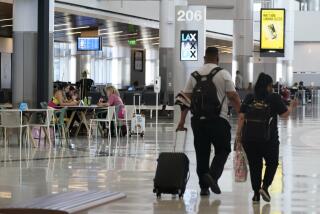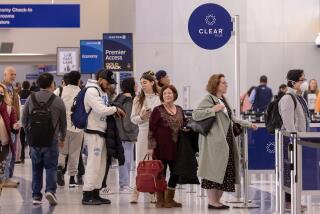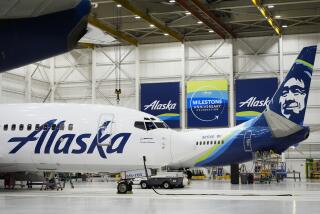Flight attendants union wants combat training
- Share via
The federal government has made clear its strategy for cracking down on potential terrorist attacks in airplanes: more sophisticated scanners and increased scrutiny of passengers at crowded airports.
But now the nation’s flight attendants say the government needs to ratchet up security measures inside airplanes.
The Assn. of Flight Attendants has been lobbying Congress for the last month or so to adopt its strategy for stronger counter-terrorism measures. The group hopes that lawmakers will include money to put some of their ideas into action under an upcoming funding bill for the Federal Aviation Administration.
The group, which represents more than 55,000 attendants at 20 airlines, wants to implement a four-point plan:
* Institute mandatory hand-to-hand combat training for all crew members.
* Equip flight attendants with portable communications devices so they can speak to the pilots during emergencies.
* Standardize the size of carry-on luggage so that flight attendants can look for suspicious passengers instead of struggling with oversized bags.
* Shut down onboard wireless Internet during high-threat periods to prevent terrorists from communicating with collaborators on the ground.
“For better or for worse, once the cabin doors close, the flight attendants are the last line of defense,” said Corey Caldwell, a spokeswoman for the association.
She pointed out that combat training for flight attendants is now voluntary, with employees who take it attending the lessons on their own time.
A portable communications system would have allowed flight attendants to talk with the pilots during the attempted attack on a Northwest Airlines flight on Christmas Day, she added. On that flight from Amsterdam to Detroit, a Nigerian national allegedly tried to ignite an explosive hidden in his underwear.
The nation’s airlines have not agreed on a maximum size for carry-on luggage because the overhead bins vary in size according to airplane model. The group suggests the standard size be no bigger than 22 inches by 9 inches by 14 inches -- the same limit already in place at American, Continental and Delta airlines. Virgin America, Southwest and Hawaiian airlines allow bigger carry-on bags.
“By having uniform standards, everybody would be on the same page,” she said.
As for shutting down the onboard Internet, she said the Transportation Security Administration would determine when the airlines are at a high risk for a terrorist attack.
Caldwell said the association has not come up with a price tag for the changes and is not seeking raises for flight attendants as part of the deal.
“We are not taking on more responsibility,” she said. “We just want more tools to make the plane safer.”
Reading possible terrorists’ clues
When it comes to airport security, an Israeli company has proposed an intriguing technology designed to read the minds of would-be terrorists.
WeCu Technologies (as in “we see you”) claims it has devised a method to identify airline passengers with bad intentions by reading the reactions of passengers to certain “stimuli.”
In the system being tested in Israel, projectors at airport terminals would flash different images associated with a certain terrorist group or symbols that only a would-be terrorist would recognize.
The assumption is that people cannot hide their reactions to certain images, just as anyone might react to a photo of a close relative suddenly appearing on a wall. The technology would use hidden cameras aimed at the passing face to capture and analyze even the most subtle reactions. Even an averted glance or a slight increase in heart rate could signal a passenger’s intentions.
If the cameras pick up suspicious looks or movement, the passenger can be pulled aside for further screening.
“One by one you can screen out from the flow of people those with specific malicious intent,” WeCu Chief Executive Ehud Given told the Associated Press.
Looking beyond the on-time rates
Because of a steep drop in passenger demand, most airlines are running fewer flights, and as a result are getting in and out of airports on time.
Statistics from the U.S. Department of Transportation show that the nation’s airlines have the best overall on-time arrival rate since 2003.
But that doesn’t make a difference to FlyersRights. org, an airline consumer rights group that issues an annual airline report card based on different statistics.
In a report card issued last month, the group handed out nearly three times as many F’s as A’s.
According to the FlyersRights report card, JetBlue, Comair and Delta airlines were among 11 carriers that received the worst marks for on-time performance, while Alaska and Hawaiian were among four that earned A’s.
One set of grades was based on the frequency of flights being delayed more than three hours. The group graded each airline based on delays per total flights. So, JetBlue got an F for having one flight delayed for every 2,776 flights, while Alaska earned an A for one three-hour-plus delay for every 137,322 flights.
New York’s John F. Kennedy International Airport won the dubious distinction of having the most flights -- 195 flights -- delayed more than three hours.
An airline’s on-time performance has taken on new importance since federal regulators adopted penalties last year for airlines that leave passengers stranded on the tarmac too long.
Under new federal regulations that take effect next month, airlines must give passengers the option to disembark if a flight is stuck on the tarmac for more than three hours. Airlines that fail to comply could be fined up to $27,500 per passenger. That could amount to $5.5 million for a jet carrying 200 people.
Most airline representatives are tight-lipped about how they plan to avoid the fines.
But at least one major U.S. airline has devised detailed plans for every airport to ensure that passengers are unloaded from the plane before the three-hour mark, according to an airline representative. He asked not to have himself or his airline identified because he was not authorized to speak on the subject.
In cases in which a delayed plane cannot pull back to the terminal because of congestion, he said, the passengers could be asked to climb out of the plane via a portable staircase onto the tarmac. This could be a nasty scene at Kennedy airport in the dead of winter, he said. “It’s going to be pretty ugly.”
More to Read
Sign up for Essential California
The most important California stories and recommendations in your inbox every morning.
You may occasionally receive promotional content from the Los Angeles Times.










